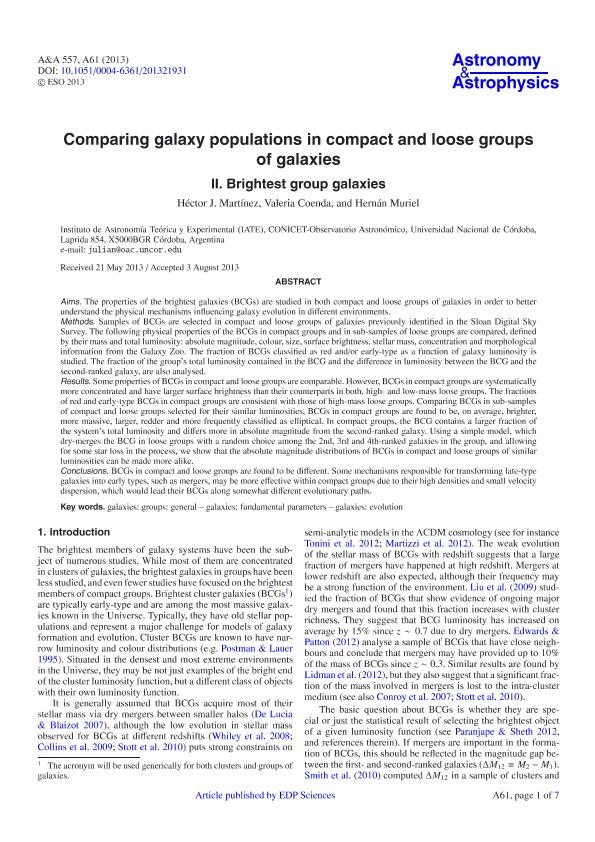Mostrar el registro sencillo del ítem
dc.contributor.author
Martinez, Hector Jose Ariel

dc.contributor.author
Coenda, Valeria

dc.contributor.author
Muriel, Hernan

dc.date.available
2017-10-04T13:32:31Z
dc.date.issued
2013-08
dc.identifier.citation
Martinez, Hector Jose Ariel; Coenda, Valeria; Muriel, Hernan; Comparing galaxy populations in compact and loose groups of galaxies: II. Brightest group galaxies; EDP Sciences; Astronomy and Astrophysics; 557; 8-2013; 1-7; A61
dc.identifier.issn
0004-6361
dc.identifier.uri
http://hdl.handle.net/11336/25840
dc.description.abstract
Aims: The properties of the brightest galaxies (BCGs) are studied in both compact and loose groups of galaxies in order to better understand the physical mechanisms influencing galaxy evolution in different environments. Methods: Samples of BCGs are selected in compact and loose groups of galaxies previously identified in the Sloan Digital Sky Survey. The following physical properties of the BCGs in compact groups and in sub-samples of loose groups are compared, defined by their mass and total luminosity: absolute magnitude, colour, size, surface brightness, stellar mass, concentration and morphological information from the Galaxy Zoo. The fraction of BCGs classified as red and/or early-type as a function of galaxy luminosity is studied. The fraction of the group’s total luminosity contained in the BCG and the difference in luminosity between the BCG and the second-ranked galaxy, are also analysed. Results: Some properties of BCGs in compact and loose groups are comparable. However, BCGs in compact groups are systematically more concentrated and have larger surface brightness than their counterparts in both, high- and low-mass loose groups. The fractions of red and early-type BCGs in compact groups are consistent with those of high-mass loose groups. Comparing BCGs in sub-samples of compact and loose groups selected for their similar luminosities, BCGs in compact groups are found to be, on average, brighter, more massive, larger, redder and more frequently classified as elliptical. In compact groups, the BCG contains a larger fraction of the system’s total luminosity and differs more in absolute magnitude from the second-ranked galaxy. Using a simple model, which dry-merges the BCG in loose groups with a random choice among the 2nd, 3rd and 4th-ranked galaxies in the group, and allowing for some star loss in the process, we show that the absolute magnitude distributions of BCGs in compact and loose groups of similar luminosities can be made more alike. Conclusions: BCGs in compact and loose groups are found to be different. Some mechanisms responsible for transforming late-type galaxies into early types, such as mergers, may be more effective within compact groups due to their high densities and small velocity dispersion, which would lead their BCGs along somewhat different evolutionary paths.
dc.format
application/pdf
dc.language.iso
eng
dc.publisher
EDP Sciences

dc.rights
info:eu-repo/semantics/openAccess
dc.rights.uri
https://creativecommons.org/licenses/by-nc-sa/2.5/ar/
dc.subject
Galaxies: Groups: General
dc.subject
Galaxies: Fundamental Parameters
dc.subject
Galaxies: Evolution
dc.subject.classification
Otras Ciencias Físicas

dc.subject.classification
Ciencias Físicas

dc.subject.classification
CIENCIAS NATURALES Y EXACTAS

dc.title
Comparing galaxy populations in compact and loose groups of galaxies: II. Brightest group galaxies
dc.type
info:eu-repo/semantics/article
dc.type
info:ar-repo/semantics/artículo
dc.type
info:eu-repo/semantics/publishedVersion
dc.date.updated
2017-10-03T18:24:47Z
dc.journal.volume
557
dc.journal.pagination
1-7; A61
dc.journal.pais
Francia

dc.description.fil
Fil: Martinez, Hector Jose Ariel. Consejo Nacional de Investigaciones Científicas y Técnicas. Centro Científico Tecnológico Conicet - Córdoba. Instituto de Astronomia Teórica y Experimental. Universidad Nacional de Córdoba. Observatorio Astronómico de Córdoba. Instituto de Astronomia Teórica y Experimental; Argentina
dc.description.fil
Fil: Coenda, Valeria. Consejo Nacional de Investigaciones Científicas y Técnicas. Centro Científico Tecnológico Conicet - Córdoba. Instituto de Astronomia Teórica y Experimental. Universidad Nacional de Córdoba. Observatorio Astronómico de Córdoba. Instituto de Astronomia Teórica y Experimental; Argentina
dc.description.fil
Fil: Muriel, Hernan. Consejo Nacional de Investigaciones Científicas y Técnicas. Centro Científico Tecnológico Conicet - Córdoba. Instituto de Astronomia Teórica y Experimental. Universidad Nacional de Córdoba. Observatorio Astronómico de Córdoba. Instituto de Astronomia Teórica y Experimental; Argentina
dc.journal.title
Astronomy and Astrophysics

dc.relation.alternativeid
info:eu-repo/semantics/altIdentifier/doi/http://dx.doi.org/10.1051/0004-6361/201321931
dc.relation.alternativeid
info:eu-repo/semantics/altIdentifier/url/https://www.aanda.org/articles/aa/abs/2013/09/aa21931-13/aa21931-13.html
Archivos asociados
